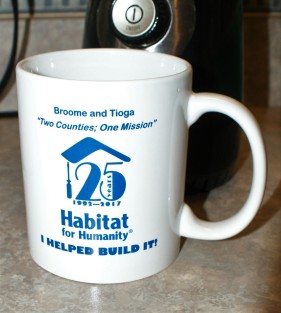
{Lent 2017 continues with reflections based on mugs waiting for coffee in our kitchen. Working our way to forty.}
When you look at the date on this mug, you see that it’s obviously the newest of the lot. I once worked with the Tioga County affiliate of Habitat for Humanity, and my wife Joan was on the board of the neighboring Broome County HFH. Mine folded into hers, mine being the smaller group, with fewer volunteers and a tired Board of Directors.
My first Habitat for Humanity involvement was limited to making a quick little video for the Richmond, Virginia affiliate. In that larger city, resources were plentiful, but so was the need for affordable, safe housing. The video showed work on three or four homes going up at the same time. Our church was very involved. That congregation contributed financial resources and enough volunteers to build at least one home on its own. And probably more than one home through the years.
After we’d been away from Richmond a few years, we happened to be visiting that church one Sunday when volunteers were being commissioned for the next build. There were saw horses in the front of the sanctuary, and some 2X4 boards that would be used in construction. Church folk were invited to sign their names to the boards so that they’d have a place in the finished studs of the walls. Paint cans held contributions, and prayers held high hopes for a family that would call that house a home.
[An important note: the families that partner in the building of their homes contribute 500 hours or so of “sweat equity,” as well as paying off a no-interest mortgage on their new house. It is a common misconception that HFH gives homes away for free. No, they don’t.]
When we moved to Vermont, I got much more involved in the local affiliate there. It was a different animal in rural Vermont. The building season up in the northeast part of the state was very short due to the cold climate. Volunteers were far fewer, with most potential workers busy on their farms or working in professional building trades trying to make their own living during that short construction season. And the churches were very small, unable to make large contributions to support the mission. Still, the need was great. Despite the romantic “Currier and Ives” image of Vermont, substandard homes strained under the weight of heavy snowfalls, woodstoves labored to keep homes warm, and a weathered look meant thin skins (exterior paint coverings) let cold winds seep into rustic homesteads.
Much of our work was accomplished by work crews from outside the state. For example, a group of college students (even high school teens) would stay in church basements, work on a home for a week, and go back home, to be replaced the following week by another crew. And rather than expend a huge commitment to build a new home, our affiliate did rehab work on old homes. We could improve the living conditions of several neighbors by repairing roofs, adding a coat of paint, rebuilding porches, etc., instead of spending two or three summers to build one new home for a family. The national headquarters didn’t always smile on our more humble efforts, but that was the reality in the Northeast Kingdom of Vermont.
Again, that small Habitat affiliate struggled to find work crews, coordinate their availability and skills with our current projects, locate housing and showers for the crews, and fund construction materials and supplies. The board was small and it was difficult to find local volunteers to serve on committees and help with building and rehabs. One couple, a retired minister and his wife, provided the leadership and coordination year after year, until the husband became too ill to continue. Eventually the affiliate had to close. It was a sad day.
When Joan and I moved to upstate New York, the Habitat board in the county to which we’d moved had just discovered that an embezzlement had decimated its financial accounts. I offered to produce a documentary about the current home it was working on, and somehow wound up on the board. Long story, short… though it built more homes than the Vermont affiliate had, it had trouble recruiting fresh blood for work crews and board membership, and while its finances grew stronger, the group itself grew fatigued. As it dedicated its last home, Joan had joined with a neighboring affiliate and we saw her group absorb mine. Just in time for her affiliate’s 25th anniversary. Thus, the mug.
All that personal biographical information is meant to say that we regard the ministry of HFH’s founder Millard Fuller as a valuable contribution to meet a global need through local efforts. When a local church partners with Habitat for Humanity to provide a safe, affordable, and energy efficient home for a qualifying family in need, the people of that community of faith discover skills they may not have known they had, see progress from the foundation to the roof top, and witness to the fruits of compassion and hospitality. With its Christian roots, this housing ministry has grown into an interfaith effort, and watching all the Children of Abraham join in a common cause wielding hammers and paint brushes alongside a partner family about to own its home for the first time — that is a sign of hope, whether in downtown D.C., a suburb of Tempe, AZ, or anywhere in Haiti’s storm-ravaged landscape.
www.Habitat.org is full of helpful information.
To lighten things up a bit for tomorrow, the next mug says “Sax in the Morning.”
Leave a comment